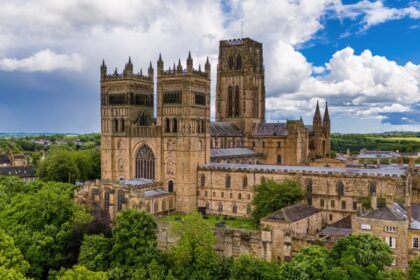Portmeirion is a place that makes you question your map-reading skills. One moment you’re in a pine-fringed corner of North Wales, the next you appear to have stumbled into a film set of pastel palazzos, gilded domes, and lollipop-coloured buildings stacked like an ice cream counter in Venice. There’s even a bell tower. And a unicorn. None of it makes any geographical sense, which is half the joy.
This isn’t some tourist attraction knocked up last week either. It’s been here since 1925, the long-time daydream of architect Clough Williams-Ellis who thought Wales could do with a bit more flamboyance. He wasn’t wrong. In an age where most people were building modest homes with nice chimneys, he built a fantasy village inspired by the Italian Riviera, smuggled into Snowdonia like a smirk.
A Welsh wonder with a continental soul
Despite appearances, Portmeirion is not a theme park. No rides, no mascots, no overpriced corn dogs. It’s a real, functioning village, albeit one where nothing quite obeys the usual rules. Buildings lean at improbable angles. Colour schemes seem decided by dice roll. Statues pop up unexpectedly and rarely explain themselves.
Wander past Hercules balancing a globe and you might find a formal garden with ponds and pagodas. Turn left and there’s a 1920s mansion with a library and its own observatory. Walk down the hill and you’ll end up in the subtropical woodlands, where rhododendrons grow like they’ve been sneaking fertiliser. There are secret paths, hidden lakes, and a genuine sense that you might at any moment run into someone dressed as a Roman senator asking for directions to the gelato.
The village that starred in a cult TV show
If Portmeirion looks a little familiar, it’s probably because your uncle has made you watch The Prisoner. This gloriously oddball 1960s cult TV series used the village as its backdrop, reimagining it as an unsettling utopia where a man known only as Number Six is pursued by giant bouncing balls and never gets a straight answer.
You can still see why they chose it. Portmeirion has that perfect not-quite-right quality. Too pretty to be real, too strange to be invented. These days, fans of the show still make pilgrimages here, possibly in the hope of finding out what it all meant. They won’t. But they’ll enjoy trying.
Stay the night in style or just pop in for the day
You don’t have to stay in Portmeirion to enjoy it, but you might want to. There are 32 rooms scattered throughout the village, each with its own quirks. You might get a tower. Or a dome. Or a suite with its own spiral staircase and views across the Dwyryd Estuary that make your morning coffee feel like a grand occasion. You can also stay in the Hotel Portmeirion itself, a Grade II-listed beauty with a cocktail bar, fine dining, and a log fire that crackles with just the right level of self-satisfaction.
For day-trippers, there’s plenty to pack into a few hours. A good plan is to simply wander, ideally with an ice cream in hand, and follow whichever brightly coloured alley or ornate archway takes your fancy. Just don’t expect logic. The place is arranged like someone once saw a postcard of Florence and thought, “What if we did that, but with more fountains?”
Food, shops and a healthy disregard for minimalism
Portmeirion doesn’t believe in plain. Even the cafes look like something you’d sketch after three espressos. The gelateria is painted in pistachio green. The souvenir shop is a miniature palace. The café near the piazza has frescoes on the ceiling and cakes that look like they’ve been gilded.
There’s also a bookshop, a pottery shop (Portmeirion Pottery is a thing of pride here), and a little deli that sells things in jars you don’t need but will definitely buy. And if you’re wondering if there’s a giant chessboard somewhere in the village, yes, of course there is. What sort of fantasy village doesn’t have one?
Walks and woods and views that demand a sit down
Beyond the buildings, Portmeirion is wrapped in 70 acres of woodland that manages to be both manicured and wild. There are Japanese bridges, hidden follies, and views that make you stop mid-snack. From the cliff paths you can see out over the estuary, a great silvery swathe of water that changes mood hourly with the tides. On a misty morning, it looks like something from a Turner painting. By late afternoon, it’s all sparkling sands and circling gulls.
There are mapped trails through the woods, though as ever in Portmeirion, getting slightly lost is more fun than following directions. Just watch out for the peacocks. They don’t like being upstaged.
Getting there and why you probably should
Portmeirion is near Porthmadog, about as far west in Wales as you can go without being accused of showing off. It’s accessible by car, and there’s parking outside the main entrance. From there, you walk in through a set of gates that suggest something interesting is about to happen. It does.
In a country famous for castles and coastlines, Portmeirion is a glorious anomaly. It’s a place built not for function or defence, but simply because one man believed beauty was worth the bother. A kind of architectural joke with perfect timing. And like all the best jokes, it never quite explains itself.





